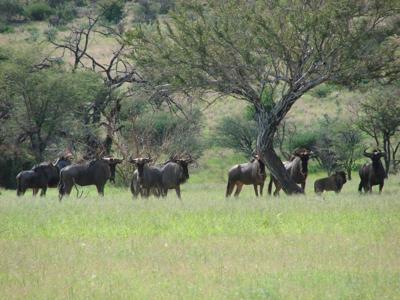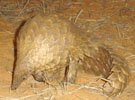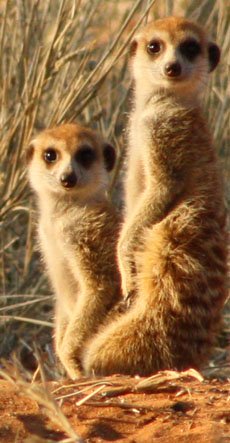For more information about our hunting safaris, don’t hesitate to reach out and contact us!
Old Fool of the Veld
by Enrique del Rosario
(Beaverton, Oregon, USA)
It behaves sometimes as if all these bits and pieces want to go in different directions. It will start to cavort around, leap up and down, and kick its heels into the air for no apparent reason.
The Afrikaners call him "wildebees", the Dutch call him "gnoe", in Kiswahili it is "nyumbu", the Xhosa say "i-ngu", and the Bushman know him as "!nu". This animal, seen by the ancient ones as "the old fool of the veld", is the unmistakable wildebeest of Africa.
Blue Wildebeest or brindled gnu, Connochaetes taurinus taurinus
Weight: 440 - 600 lbs (male); 370 - 516 lbs (female)
Height: 46 - 57 inches
I hadn't come to Africa to hunt wildebeest specifically. In fact, I wasn't even thinking of hunting them at all until the farm hands told us that they would like to have more meat for their up-coming celebration of Namibia's Independence Day. The professional hunter, Armin, told them that the wildebeest herd needed culling and that will provide ample meat for their feast.
The day before, we had been looking for kudu for my hunting buddy but we had not found any worthy trophies by late afternoon. We started back for the hunting lodge when we became aware of a large herd of animals. There were Blesbok, Hartebeest, Springbok, and Blue and Black Wildebeest that seemed to surround our bakkie as we drove back through the veld without headlights turned on.
Under a darkening sky, we could hear the bird-like chirps of the Wildebeest as they called to each other.
"Tomorrow we will hunt for gnu", Armin told us. "Karen has prepared a braai for us. Let's go home and enjoy."
------
After we had ontbyt, (breakfast) prepared by Armin's beautiful wife, Karen, we loaded our rifles onto the bakkie and headed for the pan where we had encountered Wildebeest the previous evening. The cool morning air would soon warm to the sun. As we travelled through this African Eden, bands of Springbok would stare transfixed at us then pronk away as we neared them.
By the time we got to where we would hunt, the day had warmed enough for us to shed our jackets. Still a couple of hundred yards from the clear area of the pan, we disembarked to make our stalk on foot. I took my rifle from the rack and checked to see that my cartridge belt held ten in the loops.
"Just three rounds in the gun, Enrique", Armin told me. "One in the chamber and two in the magazine".
Although the rifle was capable of holding five total rounds, Armin would allow his hunters to load only three at a time. This way, he explained, he can keep track of the number of shots fired and know if the gun was still loaded or was empty.
The Wildebeest is renown for its ability to absorb seemingly lethal hits from heavy caliber bullets and still run off, sometimes making tracking a necessity to retrieve the dead animal, if it is to be found at all. For this reason I chose to use a rifle in the venerable .375 Holland and Holland chambering. Capable of throwing 300 grain bullets with trajectories that match the .30-06 Springfield 180 grain loadings, yet delivering enough punch to bring down large dangerous game, the .375 H&H is considered by many experienced hunters to be the best all-around game cartridge in the world.
For fifty years and tens of thousands of times I had practiced making shots and reloading with the rifle butt still to the shoulder.
The rifle, honed to operate with silky smoothness, was a poem of wood and steel.
------
From the concealment of low acacias we saw them - two groups of Blue Wildebeest about 400 yards away. The first group were mostly females with a big bull. The bull and the females were not what we were after. It was the second group to the right and a little closer that had three sizeable males but were not big enough to challenge the big bull of the former group. However, scattered brush hid enough of their bodies from our view making it necessary to get closer for a clear shot. The Wildebeest were moving slowly, stopping to graze every few feet, oblivious to our presence.
The wind changed directions frequently making it difficult to figure out which way to go to get close enough to see the animals' vital area that would be my target. The Herero tracker would stop us every ten or so yards, to check the wind, relocate our quarry, then proceed slowly toward where he thought would be the best place to take a shot.
A sudden rush from the right - a mother warthog and three piglets break for safety, their tails high! We hold our breath and we are not detected. We resume our slow stalk. The high morning sun now beating on our exposed skin. We gain some more yards towards the group.
But inspite of our best efforts, the herd had winded us and started to move away, keeping cautious eyes and flared nostrils for the humans that were stalking them. Through the thorny acacias, greened by an uncharacteristic heavy summer rain, we tried to make out their bluish brindled bodies.
After another 20 minutes of stalking, the tracker motioned for us to join him. The tracker had done his job well, bringing us to within 75 yards of the Wildebeest. Certainly an easy shot off sticks.
------
My first shot hit just behind the front leg and a third of the way up his body. Over the bark of the gun I heard the slap of the bullet hitting the beast. It staggered momentarily and I thought it was a killing shot but it didn't go all the way down and I thought that I'd better hit him again. Flipping up the handle, I did the unimaginable - I short stroked the bolt and jammed the empty shell hard into the chamber! Fifty years of hunting experience and I make a rookie mistake!
"Damn!"
"Take another shot, Enrique!"
Frantically pulling back on the bolt, trying to clear the jam, and cussing at myself for being in too much of a hurry, I managed to eject the empty and chamber a live .375 cartridge.
In the meantime, the Wildebeest had regained its balance, wheeled about and raced off to join the other two bulls. I fired again, missing wildly. Once more, this time with great deliberation, I worked that bolt and positively placed a fresh cartridge into the chamber. The beast was picking up speed so I gave him lead and fired again. He jerked his head like he was shaking off an annoying tsetse but kept running away fast.
"Kop," said the tracker pointing to his head. That told me that my last shot had hit the gnu in the head.
I had expended three shots and had to reload my empty rifle. By now the animals were out of sight. We went to the spot where the Gnu was standing when I hit him with the first shot. Blood was everywhere telling me that it should have been a lethal wound. The tracker broke a branch at the spot where the hit was made.
An hour had gone by since my shots were fired and the sun rose high over the Kalahari thirstland, browning the exposed skin of my hands and face.
Each time we felt we were close to the wounded animal, bright crimson blood telling us that the beast should be near, the spoor would diminish and then disappear. The tracker would then go back to the last drop of blood and begin to walk a slow circle around it in hopes of picking up the next droplet of red. Time and again we would find blood and then we would lose it. Who was the "old fool" now? Me or the Gnu?
------
It was not until mid-afternoon that the tracker spotted three wildebeest. Two were grazing and a third appeared to be laying down. The wind must have shifted for they alerted and then the two standing ran off leaving one still laying. Armin peered through his binoculars to study the remaining animal. Then a big smiled broke on his face.
"That's him. You got him."
"Damn, I did, didn't I?"
A foolish grin spread over my face. Now I know there are two "old fools of the veld". Me and the Wildebeest.
Enrique del Rosario
Comments for Old Fool of the Veld
|
||
|
||
|
||
|
||
|
||
|
||
Meaning of "Uitspan"
'Uitspan' is an Afrikaans word that means place of rest.
When the Boer settlers moved inland in Southern Africa in the 1800's, they used ox carts. When they found a spot with game, water and green grass, they arranged their ox carts into a circular laager for protection against wild animals and stopped for a rest.
They referred to such an action of relaxation for man and beast, as Uitspan.
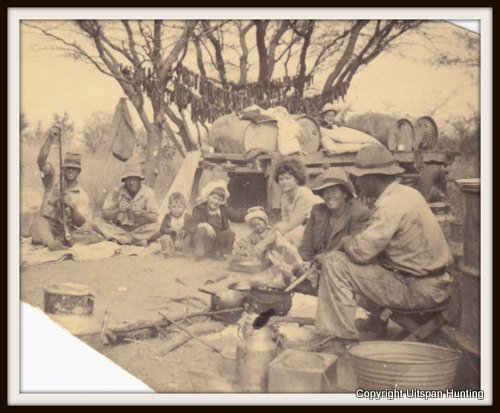
(Picture above of our ancestors.)
Did you know?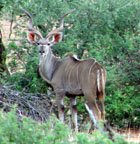 Greater Southern Kudus are famous for their ability to jump high fences. A 2 m (6.56 ft) fence is easily jumped while a 3 m (9.84 ft) high fence is jumped spontaneously. These strong jumpers are known to jump up to 3.5 m (11.48 ft) under stress. |
to read about my experience...
Did you know? Some animals have one sense more than man!The flehmen response is a particular type of curling of the upper lip in ungulates, felids and many other mammals. This action facilitates the transfer of pheromones and other scents into the vomeronasal organ, also called the Jacobson's Organ. Some animals have one sense more than man!The flehmen response is a particular type of curling of the upper lip in ungulates, felids and many other mammals. This action facilitates the transfer of pheromones and other scents into the vomeronasal organ, also called the Jacobson's Organ.This behavior allows animals to detect scents (for example from urine) of other members of their species or clues to the presence of prey. Flehming allows the animals to determine several factors, including the presence or absence of estrus, the physiological state of the animal, and how long ago the animal passed by. This particular response is recognizable in males when smelling the urine of a females in heat. |
